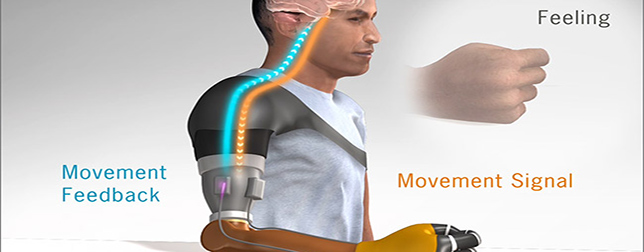A research team led by Cleveland Clinic has successfully engineered a complex hand movement sensation in patients with upper limb amputations. Scientists believe in the future this breakthrough may help patients with upper limb amputations improve their ability to control prostheses, manage daily activities and improve their quality of life.
“By restoring the intuitive feeling of limb movement – the sensation of opening and closing your hand – we are able to blur the lines between what the patients’ brains perceived as ‘self’ versus ‘machine’,” says lead researcher Paul Marasco, Ph.D., head of the Laboratory for Bionic Integration in Cleveland Clinic’s Lerner Research Institute. “These findings have important implications for improving human-machine interactions and bring us closer than ever before to providing people with amputation with complete restoration of natural arm function.”
Read more Designing Exoskeletons to Interact with Humans
The novel method creates an illusory perception that the patient’s own missing hand is moving. The scientists used small, but powerful, robots to vibrate specific muscles in patients. The vibrations “turned to” the patients’ movement sensation, making them feel that their hands and fingers were moving and that they were a unified part of their own body. When the patients in the study felt their missing hands while restraining their bionic prostheses, they were able to make complex grip patterns to perform particular tasks as well or even better than able-bodied folks.

These perceptual illusions induce a sense of activity over the movements of the prosthetic hand (i.e., users feel they are controlling movements) – a sense that’s not achievable with currently available prostheses, according to Dr. Marasco.
“When hooked up to the system and without any training, our subjects say they can feel that their arm is present,” he says. “When we unhook them, they report that their arm vanishes. The brain interprets the signals from our system very effectively.”
Read more Wearable MRI Glove Provides New Viewpoint to Hand Anatomy
When an able-bodied person moves, his brain continuously receives feedback regarding the progress of his movement. This unconscious sense prevents the person from making an error in his movement, like overreaching, and allows the body to make needed adjustments. Amputees lose this necessary feedback, however, and as a result, fail to control their prostheses without keeping an eye on them carefully at all times.
The new study has revealed that when strategic muscle vibration causes a sense of missing limb movement, it gives the patients with better spatial awareness and enhanced motor control without needing to keep an eye on their prostheses. In addition, the sensation of movement made the bionic arms feel more like “self.”
The team is moving forward with exploring ways to expand these techniques in patients who lost a leg, or those who are unable to move their limbs due to a stroke.
The researchers published their findings in the journal Science Translational Medicine.












